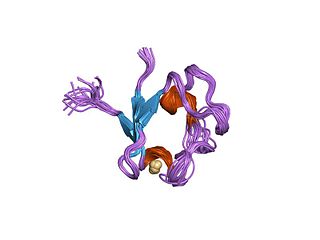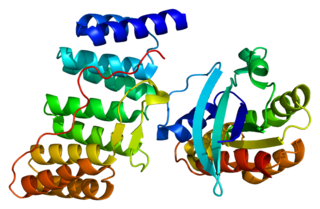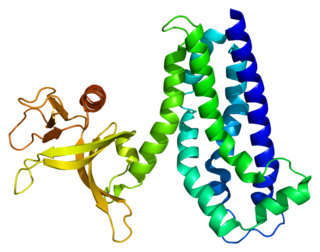Related Research Articles

Rubredoxins are a class of low-molecular-weight iron-containing proteins found in sulfur-metabolizing bacteria and archaea. Sometimes rubredoxins are classified as iron-sulfur proteins; however, in contrast to iron-sulfur proteins, rubredoxins do not contain inorganic sulfide. Like cytochromes, ferredoxins and Rieske proteins, rubredoxins are thought to participate in electron transfer in biological systems. Recent work in bacteria and algae have led to the hypothesis that some rubredoxins may instead have a role in delivering iron to metalloproteins.

Growth factor receptor-bound protein 2, also known as Grb2, is an adaptor protein involved in signal transduction/cell communication. In humans, the GRB2 protein is encoded by the GRB2 gene.

Synechococcus is a unicellular cyanobacterium that is very widespread in the marine environment. Its size varies from 0.8 to 1.5 μm. The photosynthetic coccoid cells are preferentially found in well–lit surface waters where it can be very abundant. Many freshwater species of Synechococcus have also been described.

Ku70 is a protein that, in humans, is encoded by the XRCC6 gene.

Tuberous sclerosis complex 2 (TSC2), also known as tuberin, is a protein that in humans is encoded by the TSC2 gene.

C-C chemokine receptor type 1 is a protein that in humans is encoded by the CCR1 gene.

Ras-related protein Rab-11A is a protein that in humans is encoded by the RAB11A gene.

Ribosomal protein S6 kinase alpha-1 is an enzyme that in humans is encoded by the RPS6KA1 gene.

Ras-related C3 botulinum toxin substrate 3 (Rac3) is a G protein that in humans is encoded by the RAC3 gene. It is an important component of intracellular signalling pathways. Rac3 is a member of the Rac subfamily of the Rho family of small G proteins. Members of this superfamily appear to regulate a diverse array of cellular events, including the control of cell growth, cytoskeletal reorganization, and the activation of protein kinases.

Beta-arrestin-2, also known as arrestin beta-2, is an intracellular protein that in humans is encoded by the ARRB2 gene.

Photosynthetic reaction centre proteins are main protein components of photosynthetic reaction centres (RCs) of bacteria and plants. They are transmembrane proteins embedded in the chloroplast thylakoid or bacterial cell membrane.

Dual specificity mitogen-activated protein kinase kinase 5 is an enzyme that in humans is encoded by the MAP2K5 gene.

G protein-activated inward rectifier potassium channel 4(GIRK-4) is a protein that in humans is encoded by the KCNJ5 gene and is a type of G protein-gated ion channel.

Protein phosphatase inhibitor 2 is an enzyme that in humans is encoded by the PPP1R2 gene.

Ubiquitin-conjugating enzyme E2 D3 is a protein that in humans is encoded by the UBE2D3 gene.

Triple functional domain protein is a protein that in humans is encoded by the TRIO gene.

Trafficking kinesin-binding protein 2 is a protein that in humans is encoded by the TRAK2 gene.

Origin recognition complex subunit 1 is a protein that in humans is encoded by the ORC1 gene. It is closely related to CDC6, and both are the same protein in archaea.
Avadhesha Surolia is a glycobiologist at the Indian Institute of Science (IISc), Bangalore. He was born in Kishangarh, Rajasthan, India. Presently, he is an honorary professor at the Molecular Biophysics Unit, IISc and holds the Bhatnagar fellowship of the Council of Scientific and Industrial Research (CSIR). He is known for his work on lectin structure and interactions, orientation and dynamics of cell surface carbohydrate receptors and protein folding, diabetes, antimalarials and anti-cancer agents based on curcumin, flavonoids, etc. In addition, neuropathic pain, neurodegenerative disorders and the link between immunity and obsessive–compulsive disorder are areas of his current interest

Photoautotrophs are organisms that can utilize light energy from sunlight and elements from inorganic compounds to produce organic materials needed to sustain their own metabolism. Such biological activities are known as photosynthesis, and examples of such organisms include plants, algae and cyanobacteria.
References
- 1 2 3 4 Calderon, R. H., García-Cerdán, J. G., Malnoë, A., Cook, R., Russell, J. J., Gaw, C., Dent, R. M., de Vitry, C. and Niyogi, K. K. (July 2013). "A Conserved Rubredoxin Is Necessary for Photosystem II Accumulation in Diverse Oxygenic Photoautotrophs". The Journal of Biological Chemistry. 288 (37): 26688–26696. doi: 10.1074/jbc.M113.487629 . PMC 3772215 . PMID 23900844.
{{cite journal}}: CS1 maint: multiple names: authors list (link) - ↑ Schweimer, K., Hoffmann, S., Wastl, J., Maier, U.G., Rösch, P., and Sticht H. (2000). "Solution structure of a zinc substituted eukaryotic rubredoxin from the cryptomonad alga "Guillardia theta"". Protein Science. 9 (8): 1474–1486. doi:10.1110/ps.9.8.1474. PMC 2144721 . PMID 10975569.
{{cite journal}}: CS1 maint: multiple names: authors list (link) - 1 2 Wastl, J., Duin, E. C., Iuzzolino, L., Dörner, W., Link. T., Dau, H., Lingelbach, K. and Maier U. G. (2000). "Eukaryotically Encoded and Chloroplast-located Rubredoxin Is Associated with Photosystem II". The Journal of Biological Chemistry. 275 (39): 30058–30068. doi: 10.1074/jbc.M004629200 . PMID 10878021.
{{cite journal}}: CS1 maint: multiple names: authors list (link) - 1 2 Shen, G., Zhao, J., Reimer, S. K., Antonkine, M. L., Cai, Q., Weiland, S. M., Golbeck, J. H. and Bryant, D. A. (2002). "Assembly of Photosystem II: I. Inactivation of The rubA Gene Encoding A Membrane-Associated Rubredoxin In The Cyanobacterium Synechococcus sp. PCC 7002 Causes A Loss of Photosystem I Activity". The Journal of Biological Chemistry. 277 (23): 20343–20354. doi: 10.1074/jbc.M201103200 . PMID 11914373.
{{cite journal}}: CS1 maint: multiple names: authors list (link) - ↑ Shen, G., Antonkine, M. L., van der Est, A., Vassiliev, I. R., Brettel, K., Bittl, R., Zech, S. G., Zhao, J., Stehlik, D., Bryant, D. A. and Golbeck, J. H. (2002). "Assembly of Photosystem I: II. Rubredoxin Is Required for the Assembly of Fx in Synechococcus sp. PCC 7002 As Shown by Optical and EPR Spectroscopy". The Journal of Biological Chemistry. 277 (23): 20355–20366. doi: 10.1074/jbc.M201104200 . PMID 11914374.
{{cite journal}}: CS1 maint: multiple names: authors list (link)